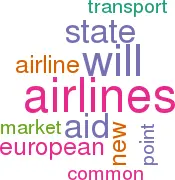EC contemplates policy developments
December 1999


At a "round table" meeting with industry experts In November (actually a rather large table as there were 150 attendees), the European Commission’s DG7 (Transport) took the opportunity of outlining some of its ideas and priorities for air transport in the near future. Two topics were of particular interest — state aid and extra–EU relations.
State aid
The Commission gave itself a hearty pat on the back for the work it has done in the twin areas of State Aid and enforcing its Market Economy Investor Principle rules. Of the seven airlines that had received state aid, six (Aer Lingus, Air France, Alitalia, Iberia, Sabena, and TAP) were now showing real improvements in levels of gearing, operating margins and productivity.
Olympic was singled out as an airline that has yet failed to implement the plans prescribed by the EC and its financial and strategic advisors.
However, EC officials pointed out that their role in this area was not necessarily completed. For although "One time, last time" principles remain in place, the EC recognises that it will almost certainly be called upon to supervise further state aid injections into airlines when the EC is further expanded with the addition of new Eastern European countries. (Ironically, the test for state aid might be simpler for some of these carriers — LOT and, potentially, Malev and CSA will have Western airline investors, any government funds will have to be provided on the same terms as from their Western partners.)
Furthermore, the EC tends to judge the success or otherwise of its policies by their effect on employment, and it would therefore be reluctant to see struggling airlines fail altogether in the next downturn. Further injections of capital are probably ruled out, but the EC does see itself playing a role in making it easier for EU airlines to merge with or take over other EU airlines.
A fundamental problem here is how to maintain both the acquiring airline’s and its takeover target’s route rights (assuming the airlines are from different EC countries) as bilaterals usually require that airlines are at least 50% owned and controlled by citizens of that state alone. This can partly explain why the EC is so determined to negotiate bilaterals on a pan- European basis.
External relations
The EC has already lost the first skirmishes with most of its own member states which have signed their own independent "Open Skies" agreements with the US.
But the new Transport Commissioner and EC Vice–President, Ms Loyola de Palacio, emphasised the need, as she saw it, for European consolidation and hence the need for the EC having its own common policy on external relations.
The starting point for this process is December 6th at the second Chicago Convention, where the EC will propose to US negotiators a new common Transatlantic Common Aviation Area (TCAA). The transatlantic market would become a free market in which any EU airline could operate from anywhere in the EU to the US, (so BA could fly Paris–New York, and existing restrictions on US airlines at Heathrow would be lifted).
Once successfully concluded, this model could then be applied across the rest on the world. Eventually an EC airline could operate from any EC point to any point in the world, and therefore what are current virtual mergers, say between KLM and Alitalia or Swissair and Sabena, could become the real thing.
Laudable as this might seem, the new Commissioner will have a major battle on her hands to make this reality. EU member states will not give up their sovereign powers easily. Ownership restriction rules will also have to be waived. And the EC will have to convince the US DoT that this is a better deal than it has at present, or feels that it can negotiate in the future on a unilateral basis.